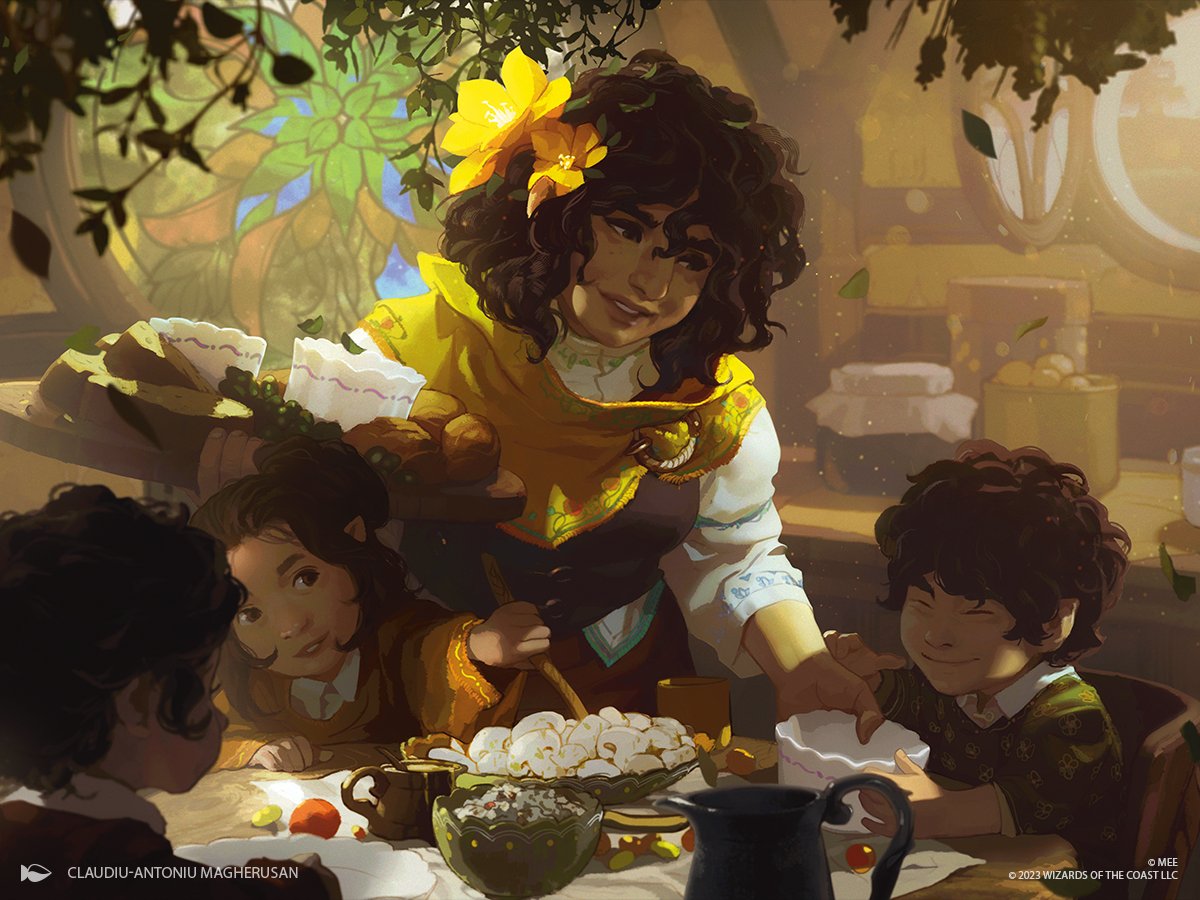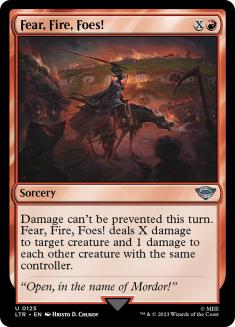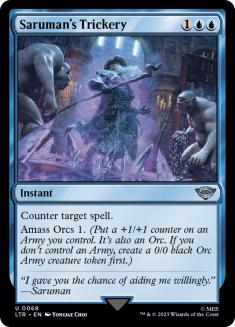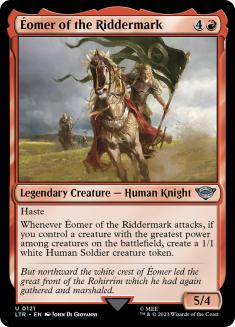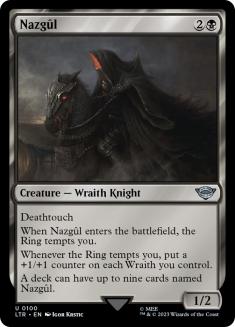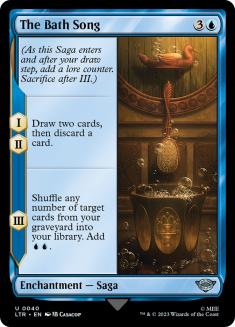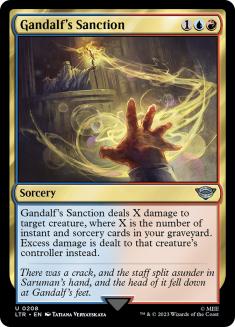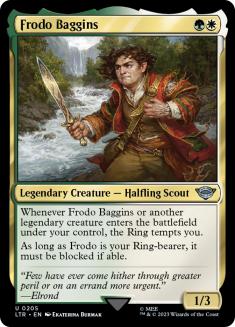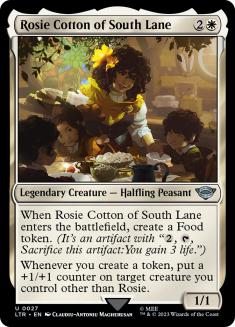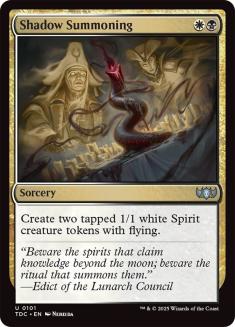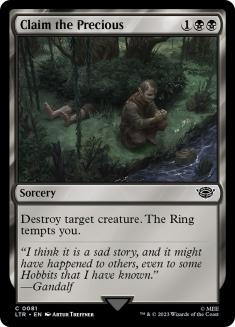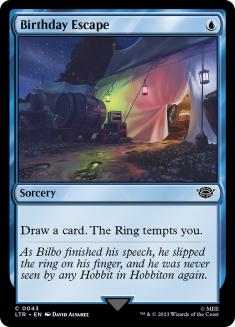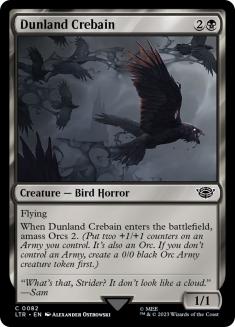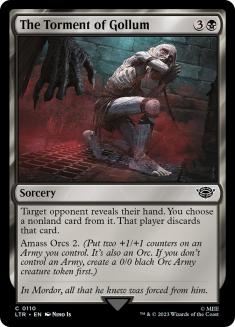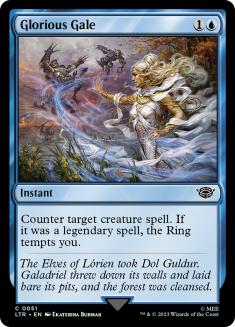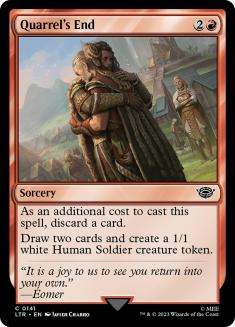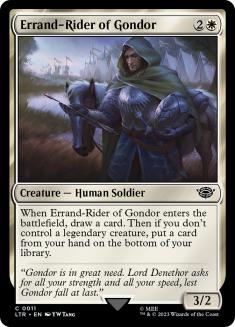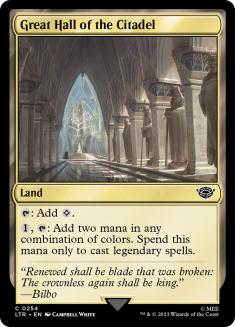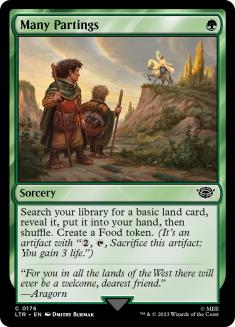With The Lord of the Rings: Tales of Middle-earth tasked with holding my interest until Wilds of Eldraine, I figured I’d compile some of my favorite commons and uncommons from the set. While these cards are amongst the strongest, I’ll do my best to include cards that don’t belong to the Grixis colors. But to be clear, the majority of the most powerful cards fall into those colors, so don’t think I’m forgetting some powerhouse cards along the way!
Uncommons
Fear, Fire, Foes!
Let’s get the obvious one out of the way first: a Fireball for creatures with the potential of simultaneously breaking your opponent’s monitor. Not only does Fear, Fire, Foes! kill about one-third of common creatures in this set, it wipes out tokens from cards like Prince Imrahil the Fair, Shadow Summoning, and Horn of Gondor. This is the most impactful uncommon of the set in terms of how much emotional (and actual) damage it can cause.
Saruman’s Trickery
This card is actually tied for the highest win-rate uncommon (Fear, Fire, Foes! Being the other) among top players. A big part of what makes counterspells great in this set is the speed of the format. With the majority of cards being cast at sorcery speed, the control player’s job becomes much more linear, and in turn, the decks become more powerful. Amass 1 is far from trivial as well, providing a Ring-bearer or chump blocker, or growing a previous threat.
Éomer of the Riddermark
This creature is an absolute beast. On Turn 5, it’s very likely Éomer will be the biggest creature on the battlefield, and only a few other non-rare creatures have five or more power anyway. Leaving behind a 1/1 blocker means that this thing can almost always attack, mitigating the opportunity for your opponent to race. This thing can snowball games, break stalemates, and wreak havoc when paired with Theoden, King of Rohan or Erkenbrand, Lord of Westfold.
Nazgûl
This card really does it all. At face value, it’s a 2/3 deathtouch creature with a tempt trigger on top, which is extremely powerful on its own, creating an attacking Ring-bearer and acting as a deathtouch blocker. But that’s not all! This creature keeps growing throughout the game, which means that your opponent will have to address it at some point before it gets too big. If you ever end up with multiples on the battlefield, the trigger puts a +1/+1 counter on each Wraith you control, so it gets out of hand immediately.
The Bath Song
The Bath Song (not “Rubber Duckie“) is an incredibly powerful Saga. Though it has no impact on the battlefield during the first two chapters, the totality of the card provides a huge advantage the later the game goes. Blue decks are able to stabilize reliably when built correctly, rarely falling too far behind when casting this card.
The Mouth of Sauron
The Mouth of Sauron has been a pet card of mine from the first time I cast it. One mistake I see players make is milling the wrong player. Sure, there are a couple of reasons other than spell count to mill a specific player, like, scry, Sam’s Desperate Rescue, or Haunt of the Dead Marshes. Aside from that, keep it simple: count the spells, then take into consideration how likely either player is to mill instants or sorceries.
Gandalf’s Sanction
Reminiscent of Zenith Flare from Ikoria: Lair of Behemoths, Gandalf’s Sanction packs a punch worthy of the comparison. While it’s uncommon to see this hit someone for fifteen or more, it does close out games. In multiples, or paired with Treason of Isengard, it can act as a win condition, but don’t be afraid to use it as a kill spell when required!
Frodo Baggins
Frodo Baggins can really warp games in interesting ways. When cast on Turn 2, or even as a late-game Ring-bearer, Frodo just starts picking off creatures with one power. The passive tempt trigger when other legendary creatures enter the battlefield is also extremely powerful. With Selesnya being one of the weakest archetypes in this set, it’s common to splash Frodo Baggins in decks with Great Hall of the Citadel that also contain plenty of legendary creatures.
Rosie Cotton of South Lane
Rosie Cotton of South Lane has grown on me to the point where I might even first-pick her. This card can absolutely take over games, and the random synergies are abundant. Cards like Bill the Pony and Protector of Gondor become more powerful, while cards like Denethor, Ruling Steward and Bilbo, Retired Burglar provide a steady stream of counters for the team.
Shadow Summoning and Denethor, Ruling Steward
I decided to pair Shadow Summoning and Denethor, Ruling Steward because I couldn’t pick a favorite. They both do a good job representing the Orzhov color pair gameplan, which is going wide and getting damage through one bit at a time. Rally at the Hornburg often outshines Shadow Summoning, but in the games where flying is relevant, the difference is remarkable. Denethor has some awesome synergies with other legendary creatures like Faramir, Field Commander; Rosie Cotton of South Lane; and Gothmog, Morgul Lieutenant. I’d flip a coin to determine which one I like better on any given day.
Commons
Claim the Precious
Claim the Precious has claimed my heart since the set’s release. I had it pinned as the best common at the start, and I still feel the same about it. The most common play pattern is to cast this during your first main phase, and attack with your Ring-bearer. This makes the sorcery-speed “drawback” much less noticeable than most would assume.
Rally at the Hornburg
Rally at the Hornburg continues to impress, though it can fall off the later the game goes. A great way to evaluate cards is by how much you dislike playing against them. I can say with confidence that in a very high percentage of games where I’m on the draw, I hope they don’t cast this card on Turn 2. Not only does it apply pressure, the 1/1’s can be great Ring-bearers during future turns; synergize well with cards like Erkenbrand, Lord of Westfold and Haradrim Spearmaster; or chump block anything that doesn’t fly (including an opposing Ring-bearer). The card does it all, and I’m happy taking as many of these as I can find.
Birthday Escape
Birthday Escape can range from decent to amazing, depending on how many tempt cards you have in your deck. If you somehow have zero, it likely won’t impact the game very much. In any deck with an average number of cards that tempt, this card becomes a very real threat. Turning any creature into an active threat and rummage effect, while drawing a card, is an amazing deal for one mana!
Dunland Crebain
Fresh off the tail feathers of Preening Champion, the Crebain brings the pain. Most cards in the set that create multiple bodies have proven to be much stronger than expected due to The Ring. This is one of the fastest creatures for amassing some Orcs, and can put the opponent on the back foot quickly.
The Torment of Gollum
The Torment of Gollum is my most drafted common for this set by a pretty large margin. I think part of that is due to the average drafter being a bit reluctant to use discard spells in Limited. The card is at its best when you can take your opponent’s best card and enable a previously outsized amass token to attack in the same turn. In addition, blue-based control can be a tough matchup for black decks, and The Torment of Gollum can be a great tool for fighting back.
Glorious Gale
Essence Scatter 2.0 is, in fact, glorious. While counterspells in Limited have a sordid past, in The Lord of the Rings: Tales of Middle-earth, they thrive. I spoke briefly about counterspells within the set under Saruman’s Trickery. For Glorious Gale in particular, with 40 of the 45 uncommon creatures being legendary, it’s not uncommon to get the free tempt trigger before you say nope.
Quarrel’s End
As a close copy of Honor the God-Pharaoh, Quarrel’s End doesn’t disappoint. Red having a Tormenting Voice type of effect is very important to refill your hand. The 1/1 token also has a lot of practical applications, most of which I touched on with Rally the Hornburg, but most importantly, it puts something on the battlefield while you draw cards.
Errand-Rider of Gondor
Errand-Rider of Gondor is my favorite white common, and I doubt I’m alone in that. While this isn’t always a three-mana Joraga Visionary, it’s very easy to make it one. White already has a plethora of legendary creatures that need errands, like Samwise the Stouthearted; Faramir, Field Commander; and Eowyn, Lady of Rohan. Of course, any creature can be legendary if you put a ring on it.
Great Hall of the Citadel
Great Hall of the Citadel is a tricky card, sometimes not even making the final deck. But when it’s good, it’s good. In multiples, this allows you to play a lot of cards previously “unsplashable”. You can now play the Flowering of the White Tree in your Dimir deck, or play Faramir, Prince of Ithilien in your Golgari deck. This land enables a lot of fun builds and splashes, with a low opportunity cost. Folks have caught on to the strength of the card, so I wouldn’t plan on wheeling these!
Many Partings
We all know that green is the weakest color in The Lord of the Rings: Tales of Middle-earth, but I wanted to make sure to get one green card into the list. Though on raw power level, it’s not quite on par with the others on the list, it can have some very useful applications, some of which I’ve outlined in a previous article about playing green.
Lose and Learn, Learn and Win!

